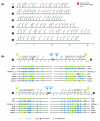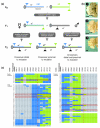A universal method for automated gene mapping
- PMID: 15693948
- PMCID: PMC551539
- DOI: 10.1186/gb-2005-6-2-r19
A universal method for automated gene mapping
Abstract
Small insertions or deletions (InDels) constitute a ubiquituous class of sequence polymorphisms found in eukaryotic genomes. Here, we present an automated high-throughput genotyping method that relies on the detection of fragment-length polymorphisms (FLPs) caused by InDels. The protocol utilizes standard sequencers and genotyping software. We have established genome-wide FLP maps for both Caenorhabditis elegans and Drosophila melanogaster that facilitate genetic mapping with a minimum of manual input and at comparatively low cost.
Figures




Similar articles
-
FLP-Mapping: a universal, cost-effective, and automatable method for gene mapping.Methods Mol Biol. 2007;396:419-32. doi: 10.1007/978-1-59745-515-2_27. Methods Mol Biol. 2007. PMID: 18025708
-
Quantitative trait loci define genes and pathways underlying genetic variation in longevity.Exp Gerontol. 2006 Oct;41(10):1046-54. doi: 10.1016/j.exger.2006.06.047. Epub 2006 Aug 17. Exp Gerontol. 2006. PMID: 16919411 Review.
-
Genetics. Revealing the dark matter of the genome.Science. 2010 Dec 24;330(6012):1758-9. doi: 10.1126/science.1200700. Epub 2010 Dec 22. Science. 2010. PMID: 21177977 No abstract available.
-
Genetic mapping with SNP markers in Drosophila.Nat Genet. 2001 Dec;29(4):475-81. doi: 10.1038/ng773. Nat Genet. 2001. PMID: 11726933
-
Insertional mutagenesis in C. elegans using the Drosophila transposon Mos1: a method for the rapid identification of mutated genes.Methods Mol Biol. 2006;351:59-73. doi: 10.1385/1-59745-151-7:59. Methods Mol Biol. 2006. PMID: 16988426 Review.
Cited by
-
Ras/MAPK Modifier Loci Revealed by eQTL in Caenorhabditis elegans.G3 (Bethesda). 2017 Sep 7;7(9):3185-3193. doi: 10.1534/g3.117.1120. G3 (Bethesda). 2017. PMID: 28751501 Free PMC article.
-
High-throughput isolation and mapping of C. elegans mutants susceptible to pathogen infection.PLoS One. 2008 Aug 6;3(8):e2882. doi: 10.1371/journal.pone.0002882. PLoS One. 2008. PMID: 18682730 Free PMC article.
-
Identification of mutations in Caenorhabditis elegans that cause resistance to high levels of dietary zinc and analysis using a genomewide map of single nucleotide polymorphisms scored by pyrosequencing.Genetics. 2008 Jun;179(2):811-28. doi: 10.1534/genetics.107.084384. Epub 2008 May 27. Genetics. 2008. PMID: 18505880 Free PMC article.
-
LEM-3 - A LEM domain containing nuclease involved in the DNA damage response in C. elegans.PLoS One. 2012;7(2):e24555. doi: 10.1371/journal.pone.0024555. Epub 2012 Feb 23. PLoS One. 2012. PMID: 22383942 Free PMC article.
-
Systemic Regulation of RAS/MAPK Signaling by the Serotonin Metabolite 5-HIAA.PLoS Genet. 2015 May 15;11(5):e1005236. doi: 10.1371/journal.pgen.1005236. eCollection 2015 May. PLoS Genet. 2015. PMID: 25978500 Free PMC article.
References
-
- Kwok PY, Chen X. Detection of single nucleotide polymorphisms. Curr Issues Mol Biol. 2003;5:43–60. - PubMed
Publication types
MeSH terms
LinkOut - more resources
Full Text Sources
Molecular Biology Databases

